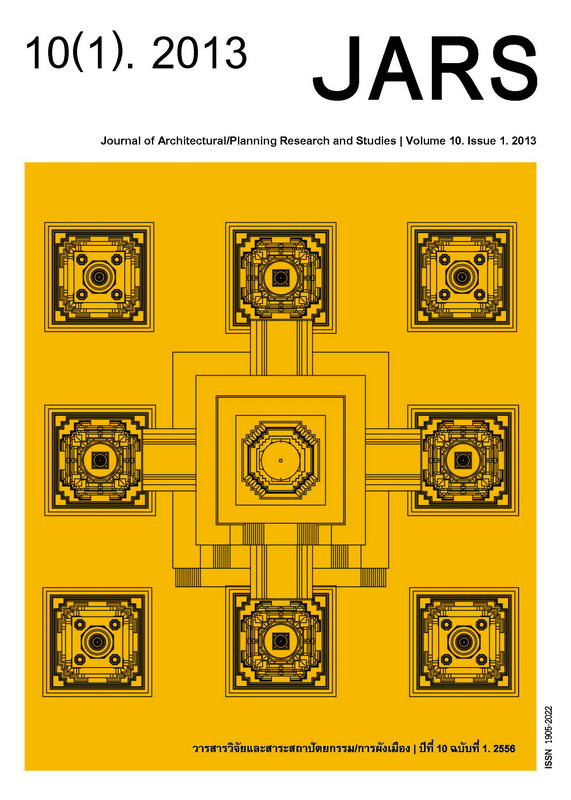Relationship and Knowledge Management in Construction Projects in Thailand Part 2: The Studies of Knowledge Management Process and the Three-stage Project Development Performance Improvement Framework
Main Article Content
Abstract
Downloads
Article Details

This work is licensed under a Creative Commons Attribution-NonCommercial-NoDerivatives 4.0 International License.
All material is licensed under the terms of the Creative Commons Attribution 4.0 International (CC-BY-NC-ND 4.0) License, unless otherwise stated. As such, authors are free to share, copy, and redistribute the material in any medium or format. The authors must give appropriate credit, provide a link to the license, and indicate if changes were made. The authors may do so in any reasonable manner, but not in any way that suggests the licensor endorses you or your use. The authors may not use the material for commercial purposes. If the authors remix, transform, or build upon the material, they may not distribute the modified material, unless permission is obtained from JARS. Final, accepted versions of the paper may be posted on third party repositories, provided appropriate acknowledgement to the original source is clearly noted.
References
Al-bizri, S. (1995). Design management plan generator (DMPG), knowledge based system for planning the design processes in the construction industry. Thesis, (PhD). Reading, University of Reading.
Argyris, C. & Schön, D. A. (1974). Theory in practice: Increasing professional effectiveness. San Francisco, Jossey-Bass.
Boisot, M. H. (1998). Knowledge assets: Securing competitive advantage in the information economy. New York: Oxford University Press.
Boonyanan, A., Robinson, H., Fong, D. & Naoum, S. (2008). Relationship and knowledge management among construction development project members in Thailand: The clients’ perspective. In Dainty, A. (Ed.). 24th Annual Association of Researchers in Construction Management (ARCOM) Conference. Cardiff, UK.
Borgatti, S. P., Everett, M. G. & Freeman, L. C. (2002). Ucinet for windows: Software for social network analysis. Harvard: Analytic Technologies.
Chappell, D. & Willis, A. (1992). The architect in practice. Oxford: Blackwell Scientific Publications.
Construction Excellence. (2004). Knowledge management. London: Author.
Davenport, T. H. & Prusak, L. (2000). Working knowledge: How organizations manage what they know. Boston: Harvard Business School Press.
Davis, P. R. & Walker, D. H. T. (2009). Building capability in construction projects: A relationship-based approach. Engineering, Construction and Architectural Management, 16, 475-489.
Department of Trade and Industry. (1998). Rethinking construction: The report of the construction task force. Norwich: HMSO.
Egbu, C. O. & Robinson, H. S. (2005). Construction as a knowledge-based industry. In Anumba, C., Egbu, C. & Carrillo, P. (Eds.), Knowledge management in construction. Oxford: Blackwell Publishing.
Fruchter, R. & Demian, P. (2005). Corporate memory. In Anumba, C., Egbu, C. & Carrillo, P. (Eds.), Knowledge management in construction. Oxford: Blackwell Publishing.
Hildreth, P., Wright, P. & Kimble, C. (1999). Knowledge management: Are we missing something? In Brooks, L. & Kimble, C. (Eds.), 4th UKAIS Conference. York, UK.
Hosking, D. M. & Morley, I. E. (1991). A Social psychology of organizing: People, orocesses and contexts. Hemel Hampstead: Harvester Wheatsheaf.
Hoskisson, R. E., Hitt, M. A., Wan, W. P. & Yiu, D. (1999). Theory and research in strategic management: Swings of a pendulum. Journal of Management, 25, 417-456.
Kamara, J. M., Anumba, C. J. & Evbuomwan, N. F. O. (2000). Process model for client requirements processing in construction. Business Process management Journal, 6, 251-279.
Kim, J. H. (2003). An approach to facilitate knowledge streams of occasional individual building industry clients at the pre-project stage. Thesis, (PhD). Reading, University of Reading.
Mohamed, S. F. (2006). Improving construction site management practices through knowledge management. Thesis, (PhD). Loughborough, Loughborough University.
Morris, P. W. G. & Loch, I. (2002). Project-based learning: Learning issues in projects. London: University Colledge London.
Nonaka, I. & Takeuchi, H. (1995). The knowledge-creating company: How Japanese companies create the dynamics of innovation. New York: Oxford University Press.
Olomolaiye, A. O. (2007). The impact of human resource management on knowledge management for performance improvements in construction organisations. Thesis, (PhD). Glasgow, Glasgow Caledonian University.
Porter, M. E. (1980). Competitive strategy: Techniques for analyzing industries and competitors. New York: Free Press.
Pryke, S. D. (2004). Analysing construction project coalitions: Exploring the application of social network analysis. Construction Management and Economics, 22, 787-797.
Pryke, S. D. & Smyth, H. (2006). The management of complex projects: A relationship approach. Oxford: Blackwell.
Quintas, P., Lefrere, P. & Jones, G. (1997). Knowledge management: A strategic agenda. Long Range Planning, 30, 385-391.
Royal Institute of British Architects. (2008). RIBA outline plan of work 2007. London: Author.
Ryd, N. & Friestedt, S. (2007). Transforming strategic briefing into project brief: A case study about client and contractor collaboration. Facilities, 25, 185-202.
Senge, P. M. (1992). The fifth discipline: The art and practice of the learning organization. London: Century Business.
Sexton, M. & Barrett, P. (2003). A literature synthesis of innovation in small construction firms: Insights, ambiguities and questions. Construction Management and Economics, 21, 613-622.
Smith, J., Love, P. E. D. & Wyatt, R. (2001). To build or not to build: Assessing the strategic needs of construction industry clients and their stakeholders. Structural Survey, 19, 121-132.
Toor, S. U. R. & Ogunlana, S. (2008). Problems causing delays in major construction projects in Thailand. Construction Management and Economics, 26, 395-408.
Veludo, M. D. L., Macbeth, D. & Purchase, S. (2006). Framework for relationships and networks. Journal of Business & Industrial Marketing, 21, 199 - 207.
Vorasubin, P. & Chareonngam, C. (2007). Strategic assets driving financial capability of Thai construction firms. Journal of Financial Management of Property and Construction, 12, 87-94.
Weick, K. E. (1995). Sensemaking in organizations. Thousand Oaks: SAGE Publications.
Wenger, E. (1998). Communities of practice: Learning, meaning and identity. Cambridge: Cambridge University Press.


